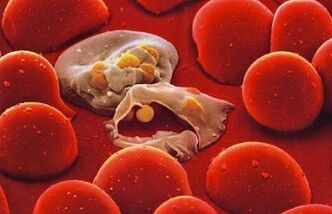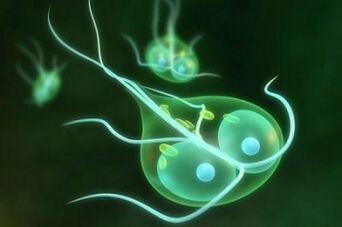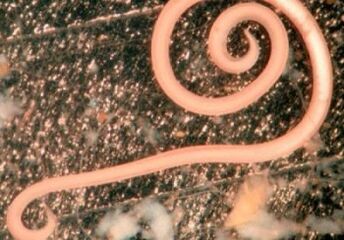Parasites often prevent a person from living normally because they severely weaken the body. What representatives most often parasitize in us, as well as how to deal with them - will tell the article.
Parasites are creatures that live and feed on their host. They can inhabit all animals, fish, birds, and humans. This creates a lot of problems because these creatures are very detrimental to health. Parasites in the human body can live in the liver, intestines, blood, and even attack the brain and lungs. What are the most common species? There are several different categories of parasites: flatworms and roundworms, protozoa and insects. How they affect the body and how to expel them - the article will tell.
Types of parasites

As already mentioned, there are different types of parasites in the human body:
- protozoa (trypanosome, malarial plasmodia, lamblia, dysenteric amoeba);
- flatworms (feline methyl, liver methyl, bovine and porcine tapeworms);
- roundworms (roundworms, pinworms);
- insects (lice, gadflies, fleas);
- chelicerae (mites).
These species most often attack the human body. They are all united by the fact that they feed on the juices and tissues of their host, slowly killing it. It is difficult to expel any of them, because each has many attachments (shoots, hooks, chelicerae), and some even settle in the cells of the body, from where it is simply impossible to expel them.
Probably everyone knows about lice, fleas and ticks, because these creatures live on the surface of the body, they are easy to find and a little easier to fight. But not everyone is aware of the internal parasites in the body and in fact they are the most dangerous to health.
The simplest
These small organisms are found everywhere:
- in water;
- land;
- air.
It is impossible to see them because they consist of only one cell. There are harmless representatives: ciliated shoe, protea amoeba, green euglena and others. Some even help animals, such as eyelashes grind grass pulp for cows, but there are many parasites among this abundance.
Plasmodium falciparum

This native of Central Africa haunts many countries today. Plasmodium malaria is transmitted by mosquitoes of the genus Anopheles, which are not particularly picky, and the main thing for them is heat and water. Many countries have carried out disease prevention: they have drained the swamps, destroyed the larvae and the disease has receded there, but the parasite is still raging in the Central African and South American region.
Once in the body, Plasmodium falciparum goes through two stages: liver and erythrocyte. The first passes in a few hours. Plasmodium attacks the liver cells, enters them, begins to multiply and feeds on the nutrients of the host. At this time a person already feels the first unpleasant symptoms:
- headache;
- nausea;
- Lack of appetite.
After a few days, the parasite leaves the liver in the bloodstream and settles in the red blood cells. He has lived there for a long time. Every 3-4 days he leaves one and enters the other. The outcome is accompanied by the separation of waste products from the protozoa, due to which the owner's temperature rises rapidly and strongly, fever, vomiting and intestinal disorders begin.
Plasmodium malaria is difficult to treat because the parasite hides in host cells. When the main symptoms of the disease appear, it is necessary to call an ambulance and constantly water the patient before his arrival, as temperature and fever cause dehydration. Plasmodium type (there are more than 5 of them) will be installed in the hospital and treatment will be prescribed.
Prevention is simple - surround your place of residence with a mosquito net if there are places for breeding Anopheles mosquitoes in the area, as well as drainage of swamps or flooding their surface with special means that create a film through which mosquito larvae can notto breathe and die.
Giardia and amoeba dysentery

Both parasites live in the human digestive system and any animal can become their host. They enter the body along with dirty water, unwashed fruits or vegetables. Their favorite places are the liver ducts, the small intestine and the upper part of the colon.
The symptoms will not be late and it is difficult not to notice them. The first manifestations are disorders of the stool. Over time, the temperature rises sharply, begins severe diarrhea and vomiting. Most often a person dies from dehydration, because the last two symptoms practically do not stop, the patient quickly loses water.
Fighting these parasites consists of drinking very clean boiled water and taking special sachets of salt - preparations containing a special composition of salts that help retain water in the body. Prevention is also simple - washing products, monitoring the condition of drinking water, because it is the source of reproduction of these parasites.
Flatworms
Parasites in the human body can be unicellular or multicellular. These are flatworms. The name comes from their shape, as they are really flat because they breathe with the whole surface of the body, so they try to reduce the volume as much as possible. There are 3 types of flatworms: cilia, flukes and tapeworms. The former are quite harmless, living on land or in water. But the second two classes are extremely parasites.
Shoots
These are small worms that have suckers in their mouths and bellies. They prefer to live in our body inside the duct of the liver and gallbladder. These helminths have two main phases of life - a larva and an adult. The larvae can host aquatic mollusks (liver flukes), fish (cat flukes), but cattle and humans are permanent.

Adults most often settle in the area of the liver, but can sometimes penetrate the intestines, lungs, and even the brain. Their accommodation is accompanied by:
- headache;
- weight loss;
- Lack of appetite;
- anemia.
They can be killed only with special anthelmintic drugs that the doctor will prescribe, depending on the type of parasite.
Prevention is simple: do not drink water and do not try to swim in bodies with stagnant water, and also do not chew hairs in the field, as many people like to do, as the larvae of flatworms can also be on the grass.
Tape
Tapeworms are so named because these parasites are long (except for echinococci), so they really look like tapeworms. They also develop with a change of "residence", but most often it is the person who is the permanent owner for them.
Beef and pork tapeworms attack the small intestine. They are attached with suction cups and hooks so that they cannot be removed from there with feces. They are constantly growing, can reach a length of 10 meters or more. They can be expelled from there only with special drugs that will kill the parasite, the shoots will relax, it will fall and come out with feces.
One of the most dangerous representatives of tapeworms is echinococcus. The host of its larva is man and herbivores, and the adult worm settles in predators. The larval stage of the parasite is dangerous because it differs in structure from the one that forms the tapeworm.
The echinococcus larva is a sac in which many larvae develop. Such a structure can attack the brain, lungs, intestines, liver. It is dangerous with its unlimited growth, because sooner or later it simply tears the tissues of the owner. If the echinococcus has struck the brain or lungs, then only surgery can save the patient, but it can also be dangerous.
If tapeworms have settled in our body, then we need to go to the hospital urgently because they are constantly growing, clogging the intestines (tapeworms), affecting the lungs or brain (echinococci), drinking all vital juices and killing their host. Prevention consists of checking the meat and fish for small white or yellowish larvae. If such are present, such a product should never be eaten!
Roundworms

Many have also heard of roundworms because they poison people's lives no less often than flatworms, especially young children. The most "famous" representatives are roundworms and pinworms, which inhabit the human intestine. Sometimes they can get into other organs: liver, eyes, brain.
Roundworms develop with a change in habitat: larvae live in a person's lungs and adults in the intestines. The name "round" characterizes their cross-sectional shape - they are really round.
These worms do not have attachments, but they do have muscles that help them withstand feces. Sometimes they themselves crawl from the body (pinworms) and lay eggs on the anus.
Children suffer from them because babies do not know the rules of hygiene, therefore, after combing the egg-laying site, they can pull their fingers into their mouths and become infected again.
Treatment is possible with drugs prescribed by a doctor. If the mother of a baby with a razor is afraid to give him pills, then you can cure him without them. To do this, it is necessary at 5-6 in the morning (at this time the female leaves the body and lays eggs around the anus) to wipe the inside of the priests with vodka and then smear the treatment area with baby cream so as not to dry the delicate skin.
Prevention consists in the fact that you must constantly monitor hygiene: wash your hands after touching the ground, do not drink dirty water.
Test for parasites
If you have doubts about your own health, you can test for parasites in the body. If any of the following symptoms occur, put a plus sign.
- Weight loss is observed without diets or changes in diet.
- The temperature is constantly rising in the region of 37-37, 5 grams.
- No appetite or, conversely, constantly want to eat.
- There is often a desire to eat something sweet.
- Increased headache.
- Hot flashes of weakness.
- Stool disorders.
- Nausea or vomiting
- Allergic rashes or swelling.
- Pain in the liver and intestines.
- Fainting (if the brain is affected).
- Trembling hands.
- Constant pallor.
If there are 1 to 4 pluses, it means that there are no worms, but the person is under constant stress, is ill or has problems with the digestive tract. If there are 5 to 7 pluses, then there is a suspicion of parasites, but more than 8 positive answers indicate real problems, so you urgently need to consult a doctor.
Parasites poison the human body, weaken the immune system, prevent them from leading a normal active life, so you need to remember about the symptoms of their manifestation and methods of treatment, as well as preventive measures, because only then can you protect your family.
























